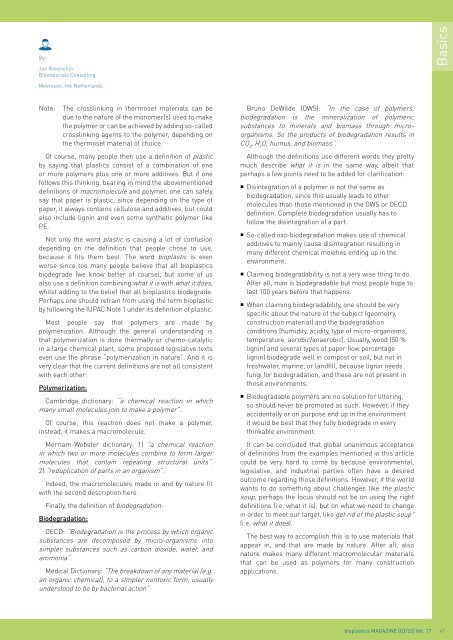Issue 03/2022
Highlights: Injection Moulding Beauty & Healthcare Basics: Biocompatibility of PHA Starch
Highlights:
Injection Moulding
Beauty & Healthcare
Basics:
Biocompatibility of PHA
Starch
You also want an ePaper? Increase the reach of your titles
YUMPU automatically turns print PDFs into web optimized ePapers that Google loves.
By:<br />
Jan Ravenstijn<br />
Biomaterials Consulting<br />
Basics<br />
Meerssen, the Netherlands<br />
Note: The crosslinking in thermoset materials can be<br />
due to the nature of the monomer(s) used to make<br />
the polymer or can be achieved by adding so-called<br />
crosslinking agents to the polymer, depending on<br />
the thermoset material of choice.<br />
Of course, many people then use a definition of plastic<br />
by saying that plastics consist of a combination of one<br />
or more polymers plus one or more additives. But if one<br />
follows this thinking, bearing in mind the abovementioned<br />
definitions of macromolecule and polymer, one can safely<br />
say that paper is plastic, since depending on the type of<br />
paper, it always contains cellulose and additives, but could<br />
also include lignin and even some synthetic polymer like<br />
PE.<br />
Not only the word plastic is causing a lot of confusion<br />
depending on the definition that people chose to use,<br />
because it fits them best. The word bioplastic is even<br />
worse since too many people believe that all bioplastics<br />
biodegrade (we know better of course), but some of us<br />
also use a definition combining what it is with what it does,<br />
whilst adding to the belief that all bioplastics biodegrade.<br />
Perhaps one should refrain from using the term bioplastic<br />
by following the IUPAC Note 1 under its definition of plastic.<br />
Most people say that polymers are made by<br />
polymerization. Although the general understanding is<br />
that polymerization is done thermally or chemo-catalytic<br />
in a large chemical plant, some proposed legislative texts<br />
even use the phrase “polymerization in nature”. And it is<br />
very clear that the current definitions are not all consistent<br />
with each other:<br />
Polymerization:<br />
Cambridge dictionary: “a chemical reaction in which<br />
many small molecules join to make a polymer”.<br />
Of course, this reaction does not make a polymer,<br />
instead, it makes a macromolecule.<br />
Merriam-Webster dictionary: 1) “a chemical reaction<br />
in which two or more molecules combine to form larger<br />
molecules that contain repeating structural units”.<br />
2) “reduplication of parts in an organism”.<br />
Indeed, the macromolecules made in and by nature fit<br />
with the second description here.<br />
Finally, the definition of biodegradation:<br />
Biodegradation:<br />
OECD: “Biodegradation is the process by which organic<br />
substances are decomposed by micro-organisms into<br />
simpler substances such as carbon dioxide, water, and<br />
ammonia”.<br />
Medical Dictionary: “The breakdown of any material (e.g.<br />
an organic chemical), to a simpler nontoxic form, usually<br />
understood to be by bacterial action”.<br />
Bruno DeWilde (OWS): “In the case of polymers,<br />
biodegradation is the mineralization of polymeric<br />
substances to minerals and biomass through microorganisms.<br />
So the products of biodegradation results in<br />
CO 2<br />
, H 2<br />
O, humus, and biomass”.<br />
Although the definitions use different words they pretty<br />
much describe what it is in the same way, albeit that<br />
perhaps a few points need to be added for clarification:<br />
• Disintegration of a polymer is not the same as<br />
biodegradation, since this usually leads to other<br />
molecules than those mentioned in the OWS or OECD<br />
definition. Complete biodegradation usually has to<br />
follow the disintegration of a part.<br />
• So-called oxo-biodegradation makes use of chemical<br />
additives to mainly cause disintegration resulting in<br />
many different chemical moieties ending up in the<br />
environment.<br />
• Claiming biodegradability is not a very wise thing to do.<br />
After all, man is biodegradable but most people hope to<br />
last 100 years before that happens.<br />
• When claiming biodegradability, one should be very<br />
specific about the nature of the subject (geometry,<br />
construction material) and the biodegradation<br />
conditions (humidity, acidity, type of micro-organisms,<br />
temperature, aerobic/anaerobic). Usually, wood (50 %<br />
lignin) and several types of paper (low percentage<br />
lignin) biodegrade well in compost or soil, but not in<br />
freshwater, marine, or landfill, because lignin needs<br />
fungi for biodegradation, and these are not present in<br />
those environments.<br />
• Biodegradable polymers are no solution for littering,<br />
so should never be promoted as such. However, if they<br />
accidentally or on purpose end up in the environment<br />
it would be best that they fully biodegrade in every<br />
thinkable environment.<br />
It can be concluded that global unanimous acceptance<br />
of definitions from the examples mentioned in this article<br />
could be very hard to come by because environmental,<br />
legislative, and industrial parties often have a desired<br />
outcome regarding those definitions. However, if the world<br />
wants to do something about challenges like the plastic<br />
soup, perhaps the focus should not be on using the right<br />
definitions (i.e. what it is), but on what we need to change<br />
in order to meet our target, like get rid of the plastic soup”<br />
(i.e. what it does).<br />
The best way to accomplish this is to use materials that<br />
appear in, and that are made by nature. After all, also<br />
nature makes many different macromolecular materials<br />
that can be used as polymers for many construction<br />
applications.<br />
bioplastics MAGAZINE [<strong>03</strong>/22] Vol. 17 47

















